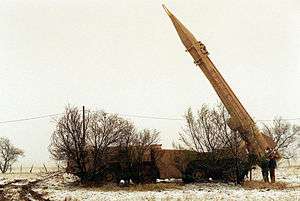Hwasong-6
| Hwasong 6 | |
|---|---|
 | |
| Type | SRBM |
| Service history | |
| In service | 1989 or 1990 |
| Production history | |
| Manufacturer | North Korea |
| Specifications | |
| Length | 12 m |
| Diameter | 0.88 m |
| Warhead | One |
|
| |
| Engine | liquid |
Operational range | 500 km (310 mi) |
Guidance system | inertial |
The Hwasong-6 (Chosŏn'gŭl: 화성 6; Hancha: 火星 6) is a North Korean tactical ballistic missile. It is derived from the Hwasong-5, itself a derivative of the Soviet R-17 Elbrus. It carries the NATO reporting name Scud.
Work on an extended-range version of the Hwasong-5 began in 1988, and with only relatively minor modifications, a new type was produced from 1989, designated Hwasong-6 ("Scud Mod. C" or "Scud-C"). It was first tested in June 1990, and entered full-scale production the same year, or in 1991. It was superseded by the Rodong-1.
To increase range over its predecessor, the Hwasong-6 has its payload deceased to 770 kg (1,700 lb) and the length of the rocket body extended to increase the propellant by 25%; accuracy is 700–1,000 meters circular error probability (CEP).[1][2][3] Such range is sufficient to strike targets as far away as western Japan. Its dimensions are identical to the original Hwasong-5. Due to difficulties in procuring MAZ-543 TELs, mobile launchers were produced in North Korea. By 1999, North Korea was estimated to have produced 600 to 1,000 Hwasong-6 missiles, of which 25 had been launched in tests, 300 to 500 had been exported, and 300 to 600 were in service with the Korean People's Army.[4]
The Hwasong-6 was exported to Iran, where it is designated as the Shahab-2, and to Syria, where it is manufactured under licence with Chinese assistance.[4]
See also
References
- ↑ Hwasong-6 (Scud-C) short-range tactical ballistic missile - Armyrecognition.com
- ↑ ‘Scud C’ Variant (Hwasong 6) - Missilethreat.csis.org
- ↑ Scud-C Variant (Hwasong 6) - Missiledefenseadvocacy.org
- 1 2 Bermudez, Joseph S. (1999). "A History of Ballistic Missile Development in the DPRK: Longer Range Designs, 1989-Present". James Martin Center for Nonproliferation Studies. Retrieved 2008-02-14.
